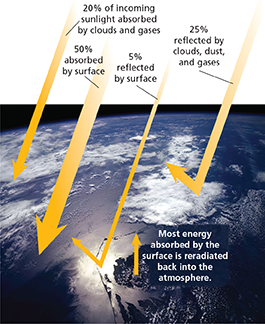24.3 Solar Energy and Winds
Reading Focus
Key Concepts
 What happens to the energy Earth receives from the sun?
What happens to the energy Earth receives from the sun? How is energy transferred within the troposphere?
How is energy transferred within the troposphere? What causes winds?
What causes winds? What are some examples of local winds and global winds?
What are some examples of local winds and global winds?
Vocabulary
greenhouse effect
wind
local wind
sea breeze
land breeze
global winds
Coriolis effect
monsoon
jet stream
Reading Strategy
Comparing and Contrasting Copy the table below. After you read, compare sea and land breezes by completing the table.
Type of Wind |
Day or Night? |
Direction of Air Movement |
|---|---|---|
Sea breeze |
a. _____ ? _____ |
b. _____ ? _____ |
Land breeze |
c. _____ ? _____ |
d. _____ ? _____ |
The heat you feel when you're out in the sun is one effect of solar energy. You might think that sunlight heats the air directly, just as it heats you directly. But the process is more complicated than that.
Energy in the Atmosphere
 Some solar energy that reaches Earth's atmosphere is reflected back, some is absorbed by the atmosphere, and some is absorbed by Earth's surface. About 30 percent of the incoming solar energy is reflected back into space by clouds, dust in the air, gases, and Earth's surface. About 20 percent of the sun's energy is absorbed by clouds and gases. But the greatest amount of solar energy—about half—passes through the atmosphere and is absorbed by the surface.
Some solar energy that reaches Earth's atmosphere is reflected back, some is absorbed by the atmosphere, and some is absorbed by Earth's surface. About 30 percent of the incoming solar energy is reflected back into space by clouds, dust in the air, gases, and Earth's surface. About 20 percent of the sun's energy is absorbed by clouds and gases. But the greatest amount of solar energy—about half—passes through the atmosphere and is absorbed by the surface.
The atmosphere is heated primarily by energy that is reradiated by Earth's surface. Unlike incoming solar energy, which has much of its energy in the visible spectrum, the energy radiated back into the atmosphere is mostly infrared radiation. Certain gases in the atmosphere, including water vapor and carbon dioxide, allow visible light to pass through but absorb most infrared radiation. These gases radiate some of this absorbed energy back to Earth's surface, warming the lower atmosphere in a process called the greenhouse effect. Without the greenhouse effect, Earth's surface would be much cooler than it is.
 Energy is transferred within the troposphere in three ways: radiation, convection, and conduction. As the How It Works box on page 756 explains, these processes work together to heat the troposphere.
Energy is transferred within the troposphere in three ways: radiation, convection, and conduction. As the How It Works box on page 756 explains, these processes work together to heat the troposphere.
Figure 11 About half of the sunlight that reaches Earth is absorbed by the surface. The rest is either reflected back into space or absorbed in the atmosphere.
 dd
dd



